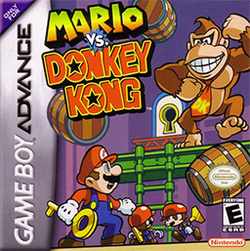Mario vs. Donkey Kong (video game)
| Mario. vs. Donkey Kong | |
|---|---|

North American box art
|
|
| Developer(s) | Nintendo Software Technology |
| Publisher(s) | Nintendo |
| Director(s) | Yukimi Shimura |
| Producer(s) | Shigeki Yamashiro Shigeru Miyamoto |
| Designer(s) | Wing S. Cho |
| Composer(s) | Lawrence Schwedler |
| Series | Mario vs. Donkey Kong |
| Platform(s) | Game Boy Advance, Virtual Console (Nintendo 3DS/Wii U) |
| Release date(s) |
Game Boy Advance
3DS Ambassador Program
|
| Genre(s) | Platforming, puzzle |
| Mode(s) | Single-player |
| Aggregate score | |
|---|---|
| Aggregator | Score |
| Metacritic | 81/100 |
| Review scores | |
| Publication | Score |
| Edge | 7/10 |
| EGM | 7.33/10 |
| Eurogamer | 8/10 |
| Famitsu | 30/40 |
| Game Informer | 7.5/10 |
| GamePro | |
| GameSpot | 8/10 |
| GameSpy | |
| GameZone | 8.5/10 |
| IGN | 8.5/10 |
| Nintendo Power | 4.5/5 |
Mario vs. Donkey Kong (マリオVSドンキーコング Mario tai Donkī Kongu?) is a 2004 puzzle-platform game developed by Nintendo Software Technology and released for the Game Boy Advance. The game is the spiritual successor to Donkey Kong, which was released in 1994 for the Game Boy. The game's first sequel, Mario vs. Donkey Kong 2: March of the Minis, was released on the Nintendo DS in 2006.
The game concept revolves around a combination of platform and puzzle elements, challenging Mario to find keys, reach a locked door, and rescue mini-Marios.
In Mario vs. Donkey Kong, the player assumes the role of Mario, who is pursuing Donkey Kong through a toy factory, who has stolen several dozen Mini-Mario toys. The game plays similarly (and has a similar ending) to the Game Boy Donkey Kong game, giving Mario the ability to perform handstands and backflips. There are several different environments, ranging from a lava environment to the classic construction site, and there are four different types; in the first, and most common, Mario has to pick up a key and take it to the locked door, and then find and pick up the Mini-Mario toy at the end of the level. The second type is where Mario must guide six Mini-Mario toys to the Toy Box, while protecting them from dangerous environments. The third type is the boss level, where Mario must fight Donkey Kong in order to proceed to the next world. The fourth type is the Plus Level, where Mario must activate one Mini-Mario in the level, which is holding a key, and take it to the door. The fifth type of level is the Expert levels. In this mode, Mario must get the key and lead it to the door, much like the first type of level, but these are the hardest levels in the game. Getting through the door beats the level in Plus and Expert modes, rather than sending Mario to a second part.
...
Wikipedia
